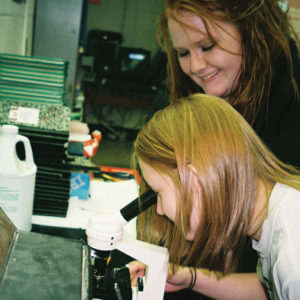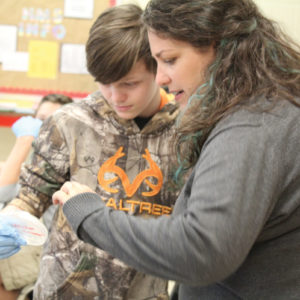By Patricia McDaniels and Katie Jones | Photos courtesy UTIA (except noted)
Listen to a podcast. Read news articles and opinion pieces. Glance through professional journals. Everywhere, pundits seem to take aim at the U.S. educational system. One UT alumna is working to improve the performance of Tennessee students—and students around the nation—through 4-H.
Jennifer Richards (Knoxville, ’07) works as a curriculum developer who aligns Tennessee 4-H with state content standards. Years ago, 4-H modernized beyond corn, cows and sows; the program continues to set its sights on relevance to today’s youth.
Richards, a former classroom teacher, taught language arts and social studies to youth during the challenging years of seventh and eighth grade. She knows the difficulties teachers face when trying to interest and motivate young people, and she knows the criteria set by stringent state curriculum guidelines.
“Every minute in the classroom is an opportunity to reach a young mind,” Richards says. “Today’s teachers don’t have the luxury of diverting classroom time to subjects or discussions that are not aligned with state standards.”

Richards holds a joint appointment between UT Extension and the Herbert College of Agriculture as an assistant professor in the agricultural leadership, education and communications (ALEC) department. As a curriculum development specialist, she works with subject-matter experts to update Tennessee 4-H curricula so that its 27 project areas complement classroom efforts while holding the attention of the youth. She “fell” into developing STEM curricula when her husband returned to UT for a post-doctoral appointment in food science while she pursued a doctorate in education with an emphasis on research, curriculum and evaluation.
“Around the time I was beginning my doctoral studies, most federal funding agencies began requiring outreach components for big research grants. I met some of the faculty in the food science department through my husband and was recruited to develop educational outreach components to accompany some grant proposals. From there, everything seemed to fall into place,” Richards says.

Richards spent more than 10 years focusing on developing educational programming that incorporates food safety concepts into a standard middle school curriculum that also teaches science, math, language arts and social studies. Her curriculum was licensed by the UT Research Foundation (UTRF) and is now available to middle school teachers across the country. Since 2006, it has helped educate more than 85,000 students in 44 states.
In 2015, Richards migrated to ALEC. The Tennessee 4-H curricula needed overhauling, and she eagerly pursued the assignment.
4-H brings educational programming, hands-on activities and educational camps to K-12 students across the nation through Cooperative Extension. The Tennessee 4-H program is managed by UT Extension, within the UT Institute of Agriculture, and is among the nation’s largest 4-H programs with more than 168,000 active members and thousands more alumni. The state program cooperates with local educational systems and home-school cooperatives to administer programming in subjects that include family and consumer sciences as well as agriculture and natural resources. The key is for the 4-H curricula to support and reinforce classroom learning.
Because extension agents serve in each of the state’s 95 counties, they bridge the gap between traditional classroom learning and extracurricular activities. However, extension agents aren’t subject-matter experts in every topic 4-H teaches. Richards helps the experts develop age- and setting-appropriate curricula that correspond with best practices. In addition to curricula aimed at student education, Richards is creating a course to prepare extension agents who don’t come from a youth-teaching background to handle the social, mental and emotional development of children at various ages and stages.

“It is an intriguing problem that’s not well documented,” she says. “How do we intentionally guide best practices in educational programming, and what does that look like in the field? The lessons must also be accessible, providing cash-strapped systems and teachers with the resources and tools to teach the materials.”
Above all, both in the classroom and in 4-H, Richards emphasizes the materials must reinforce the state standards on which students are tested while representing best practices in youth education.
To enable widespread availability of the programs, UTRF has executed four license agreements on original educational programs that Richards helped develop: the original food safety curriculum that was privately licensed; a version of the food science curricula that is available through 4-H nationally; a program for hands-on STEM labs focused on engineering design and the basic mechanics behind building bridges; and a hydroponics curriculum for high school students. In each case, Richards paired with subject-matter experts in food science, agricultural and civil engineering, and soil and plant sciences.
More curricula and updated 4-H projects are in the works, and Richards could not be more excited about the effort. “I always wanted to teach, but I never thought I would have the opportunity to impact the education of so many young people.”



